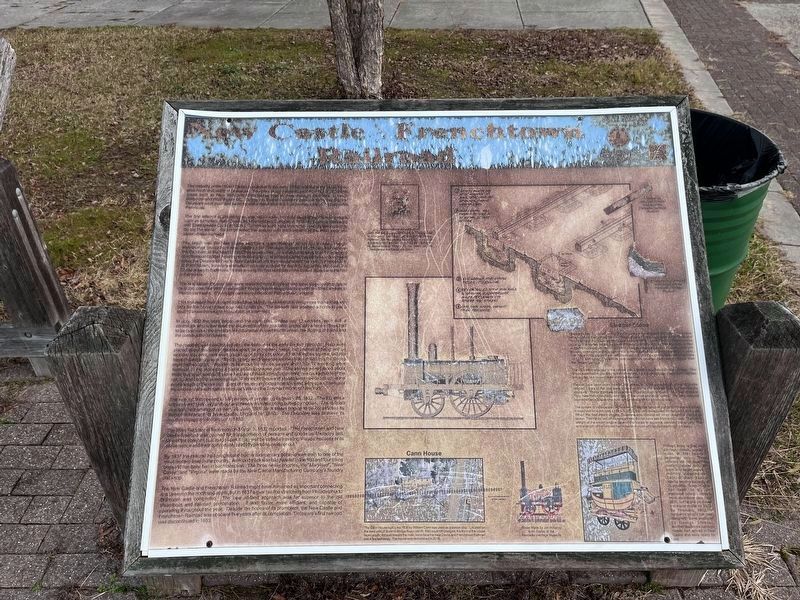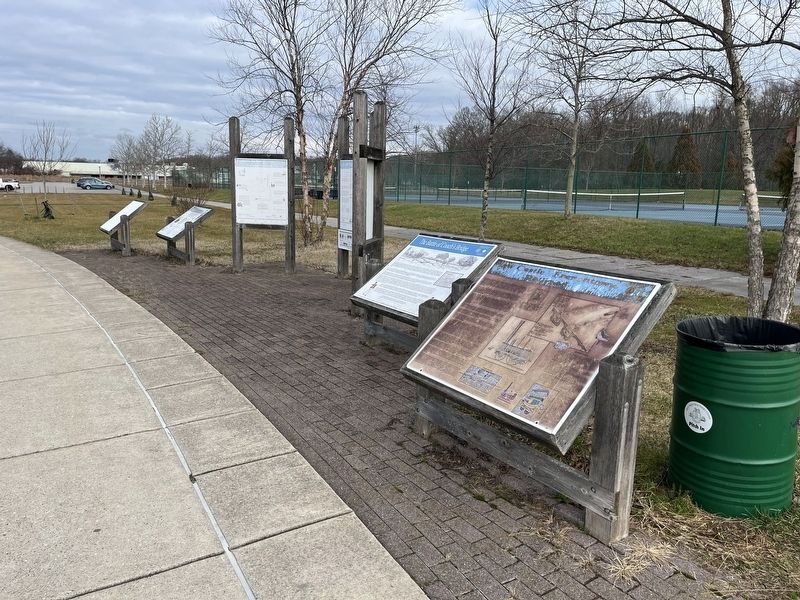Glasgow in New Castle County, Delaware — The American Northeast (Mid-Atlantic)
New Castle Frenchtown Railroad

Photographed By Devry Becker Jones (CC0), December 30, 2023
1. New Castle Frenchtown Railroad Marker
Unfortunately, the marker has weathered significantly.
The majority of the United States population in the early 1800s resided in the Mid-Atlantic area north and south of Delaware. Travelers along the east coast from higher populated areas such as New York and Philadelphia had to pass through Delaware to reach Baltimore and Washington DC. During this time of increased overland travel the roads of Delaware were poor and travel by water required a 300-mile journey around the Delmarva Peninsula.
The first attempt at providing an alternative route involved developing improved roads such as turnpikes (new Castle and Frenchtown Turnpike in 1816) and canals (Delaware and Chesapeake Canal in 1829). Turnpikes were hard to maintain and canals froze over during the winter. Steam provided the answer with the invention of the steamboat and steam-drawn carriage.
The result was the New Castle and Frenchtown Railroad which ran a nearly straight sixteen-mile course from New Castle on the Delaware River to Frenchtown, Maryland on the Elk River at the head of the Chesapeake Bay. As a result, travelers from Philadelphia (the financial capital) heading to Washington (the political capital) would take a steamboat down the Delaware River to New Castle where they would board the train to Frenchtown. At Frenchtown, travelers embarked on a steamboat for the final leg of the trip down the Chesapeake to Baltimore. It was among the first railroads in the United States and the first in Delaware.
The first steam locomotives were imported from England and local stagecoach builders built the coaches which resembled horse-drawn stagecoaches with modified wheels to ride on the tracks. The freight cars were little more than ordinary wagons.
The first experiment in railroad building literally consisted of nothing more than a road with rails for the horse drawn coaches to ride on. The smooth rails enabled a horse to pull a load 10 times the weight it could pull on a dirt road.
In July 1830 the work began and the route as divided into 17 sections, each with a contractor who supervised the excavation of the roadbed (especially where inclines had to be over come) the erection of embankments over marsh areas, the digging of drains and the construction of culverts.
The roadbed was constructed after the fashion of the early English railroads. Rails were placed about the same distance apart as in modern roads, but instead of being laid on wooden sleepers, rails were placed upon blocks of stone, 13 to 18 inches square, laid in a base of sand and gravel. Wooden plugs were inserted into two holes drilled into the stones eight inches apart. Wooden rails about six inches square and 10 or 12 feet long were fastened to the stones by a piece of

Photographed By Devry Becker Jones (CC0), December 30, 2023
2. New Castle Frenchtown Railroad Marker
The railroad first opened to full passenger service on February 28, 1832. The trip was a success and took only an hour and twenty minutes being pulled by horses. The railroad directors had arranged as early as June 1831 for a steam engine to be constructed by Robert Stevenson of New Castle, England for £850. The Delaware was to make its maiden voyage on September 1, 1832.
The Niles Register of Baltimore on March 3, 1832 reported: "The Frenchtown and New Castle Railroad was opened for transportation of persons and goods on Thursday last. One of the coaches built to run upon it may well be called a traveling 'Palace' because of its convenience and it will comfortably seat fifty persons inside or out."
By 1837 the railroad had progressed from a rudimentary horse-drawn train to one of the most modern lines in the country. A second track was laid parallel to the first and four trains began to run daily, two in each direction. The three newer engines, the "Maryland", "New Castle" and "Virginia" were made by the New Castle Manufacturing Company's foundry and shop.
The New Castle and Frenchtown Railroad might have remained an important connecting link between north and south, but in 1837 a rival rail line stretching from Philadelphia to Baltimore was completed. The new all-land approach was far superior to the old steamboat and railroad combination. It was faster, more efficient, and capable of operating throughout the year. Despite the hopes of its promoters, the New Castle and Frenchtown Railroad was obsolete five years after its completion. Delaware's first railroad was discontinued in 1853.
[Captions:]
John Randel, Jr. was employed as the engineer in charge of the New Castle and Frenchtown Railroad. He had gained his early experience as a surveyor on the Erie Canal, but became known to Delawareans chiefly for his work on the Chesapeake and Delaware Canal.
A section of Iron Rail (4) is on display at the Pencander Heritage Museum.
An original Iron Knee (5) is on display at the Pencader Heritage Museum.
Cann House
The Cann House built circa 1835 by William Cann was used as a station stop. Located on the west side of Summit Bridge Road (old Rt. 896) south of Glasgow, the front of the house faced south, not east toward the road, but to face the New Castle and Frenchtown Railroad just a few feet away. The house was demolished in 2018.
Model Made by Jim Williams is on display at the Pencader Heritage Museum.
Sleeper Stone
Granite Blocks (1) known as sleeper stones were the railroads first attempt at a base for supporting the railroad tracks. These granite stones were quarried at Smith and Megredy near Port Deposit, Maryland, and at Robinson and Carr in a Pennsylvania quarry. The stones measured approximately 13 to 18 inches square with holes drilled in them 6 inches apart. Width of these tracks were about the same as they are today with sleeper stones the entire length of the railroad buried about three feet apart in sand. The holes in the stones were used to attach the six by six wooden rails that were 10 to 12 feet long. the yellow pine scantlings (wooden rails) were shipped from Savannah, Georgia.
The rails were attached to the stones with L shaped brackets called iron knees The knees were held in place by spikes driven into the wooden plugs. Each stone had two iron knees, one on each side of the wooden rail.
It would have taken more than 58,000 stones to go the entire length of the 16½ mile railroad. Bars of flat iron were spiked on top of the wooden rails to complete the structure. These thin bars of iron were imported from England. The Nail Works of Troy, New York manufactured many of the small and large spikes. The rails were not connected side to side which allowed a clear path for a horse to walk.
The system of rails capped with metal allowed the horse to pull up to 10 times the load it could pull on a dirt road. Until July 1832, the cars were pulled on the tracks by horses. When the first steam engine Delaware was introduced other problems started to occur. The tracks laid on sleeper stones did not have ties from side to side. The heavy weight of the steam engine caused the tracks to separate derailing the engines. The entire length of the railroad had to be reinforced with ties connecting the tracks.
Richard Imlay, a Baltimore carriage maker, supplied most of the railroad passenger cars. These vehicles did not resemble modern railroad cars, but were only larger copies of ordinary stagecoaches. Each of them had an interior seating capacity of 20 persons Some models had seats on top for additional riders. Imley's most expensive cars cost $850, but he also produced by George Steever, another Baltimore carriage maker, had arrived in New Castle and were ready to use.
Erected by Pencader Heritage Area Association.
Topics and series. This historical marker is listed in these topic lists: Industry & Commerce • Railroads & Streetcars • Waterways & Vessels. In addition, it is included in the Chesapeake & Delaware (C&D) Canal series list. A significant historical date for this entry is February 28, 1832.
Location. 39° 36.494′ N, 75° 44.171′ W. Marker has been reported damaged. Marker is in Glasgow, Delaware, in New Castle County. Marker is on Pulaski Highway (U.S. 40) east of South College Avenue (Delaware Route 896), on the right when traveling west. Touch for map. Marker is in this post office area: Newark DE 19702, United States of America. Touch for directions.
Other nearby markers. At least 8 other markers are within walking distance of this location. The Battle of Cooch's Bridge (here, next to this marker); The March Through Pencader (here, next to this marker); In the Beginning … (here, next to this marker); Exploring the Past of Pencader Hundred (here, next to this marker); Lenni Lenape (a few steps from this marker); Historic Iron Ore Mining (approx. half a mile away); The Hundreds of Delaware (approx. half a mile away); a different marker also named Exploring the Past of Pencader Hundred (approx. half a mile away). Touch for a list and map of all markers in Glasgow.
Credits. This page was last revised on December 31, 2023. It was originally submitted on December 31, 2023, by Devry Becker Jones of Washington, District of Columbia. This page has been viewed 52 times since then and 30 times this year. Photos: 1, 2. submitted on December 31, 2023, by Devry Becker Jones of Washington, District of Columbia.